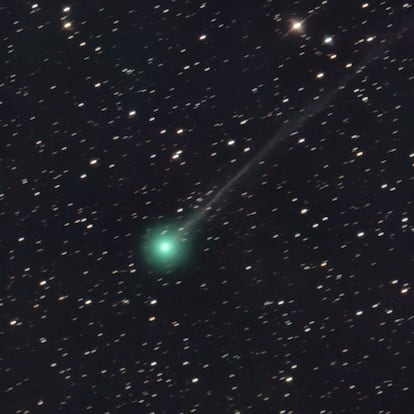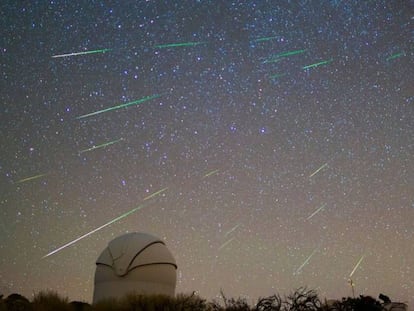Comet Nishimura’s arrival reminds us of the awe-inspiring vastness of the cosmos
Finding and tracking comets and asteroids is a crucial task in astronomy that help us understand the physics governing the universe

An amateur astronomer makes a major discovery that saves humanity from certain annihilation. This is the theme of more than a few films — think Armageddon, Don’t Look Up and Deep Impact. The films are often grounded in reality, like the crucial role of amateur astronomers in discovering comets and asteroids. Yet, it is unrealistic to think that the future of humanity can be assured by a smart guy making calculations on a blackboard, like Leonardo DiCaprio’s character in Don’t Look Up. It’s a little more complicated, but we’ll get to that shortly. The most important thing is to continuously scan the skies to identify any objects that may come close and threaten our home. We’re talking about identifying comets, which everyone can do with a little know-how and a lot of patience.
A comet named C/2023 P1 (Nishimura) is heading our way and may soon be visible to the naked eye. It was discovered on August 11-12 by Hideo Nishimura, a skilled Japanese amateur astronomer who identifies astronomical objects using a special camera. Based on the latest calculations, it will reach its closest point to Earth on September 13. The comet will be brightest when closest to the Sun on September 17, and should be visible to the naked eye if it remains intact and the tail glows brightly. Comets often break up and disappear because solar winds are very destructive. At sunset or sunrise, you can spot it near Venus in the direction of the Sun. Currently, the Sun is in the constellation of Leo, moving towards Virgo (horoscopes are only useful for knowing the Sun’s location throughout the year). In a few days, it will become difficult to see from the Western Hemisphere and will eventually drift away into space. It’s a Type C comet, which means that it’s non-periodic and will only pass by our neighborhood once (unless something happens!) Or it might return a few centuries later — no one is really sure.
What does a visit from a comet like Nishimura teach us? We’re discussing a basic physical concept that’s both fundamental and complex on a quantum scale. It involves mathematical concepts we’ve all studied, so we can put quantum indeterminacy aside and instead focus on an astronomical principle: the complete trajectory of an object orbiting another can be determined by measuring just two physical quantities at any moment: position and speed. This sounds simple enough, but the details get tricky. Both position and speed are vectors (remember those?) Knowing the position and speed of an object goes beyond determining two numbers with units. In three-dimensional space, we’re dealing with six measurements that define these two vectors.
"Comet Nishimura Grows" https://t.co/I4ewqMClmx pic.twitter.com/uImxDViguE
— Astronomy Picture of the Day (@apod_daily) September 9, 2023
Measuring a comet’s position and velocity vectors is challenging, requiring multiple observations. First, identifying a comet involves detecting its movement in the night sky, while also differentiating between two types of celestial objects. First, there are objects that appear almost stationary with respect to the Earth, like stars and galaxies. They appear to travel across the night sky due to the Earth’s rotation on its axis. Then there are objects that move rapidly relative to this rotation, causing their path to differ from the seemingly circular motion of the stars and galaxies. These objects are typically close to Earth, like planes and satellites within the Solar System.
To identify a comet, you need to capture images of the sky and look for objects that do not move in predictable circular patterns. These objects are known to have non-sidereal movement, meaning they traverse the sky — a reference system that has been around for millennia. Once an object with non-sidereal motion has been identified, we have information about its position in the sky — two coordinates. Now we need a third element — distance, which is tremendously difficult to determine directly. The same goes for speed, since we only have speed projected in the sky. We lack the object’s angle with respect to a reference axis. Again, very difficult to measure. So, how do we determine the starting point and trajectory of a newly discovered comet?
If we have the position and speed (vectors) of a star, there is only one possible orbit among the countless ones we could imagine that can account for those values. To illustrate, consider a satellite designed to revolve around the Earth’s center exactly once every 24 hours, like a fixed point on the Earth’s surface. This satellite can only be positioned at a specific distance of 22,236 miles (35,786 kilometers) above the Equator, with a speed of 1.9 miles (3.07 kilometers) per second in a direction perpendicular to the line connecting it to the center of the planet. We refer to this satellite as geostationary because it remains fixed in the sky throughout the day. This concept is fundamental for the devices we send into orbit or to explore space. To move to a different orbit, we simply need to adjust the speed of these devices by applying acceleration (positive or negative) for a short duration. The direction can be controlled as well.
Applying this basic concept is a good first step toward safeguarding our planet. Since we lacked two crucial measures to determine the position and speed of the comet, the solution is to observe it on multiple nights and apply orbit models. Using a few parameters, we can accurately determine the comet’s position in the sky. The orbit can be calculated by identifying multiple positions in the object’s trajectory. This requires a moderately powerful computer to progressively refine the orbit until convergence is achieved.
What are the most important takeaways from this long discussion of a physics problem? First, the universe is unfailingly fascinating, particularly when we witness the breathtaking beauty of comets. Yet, alongside this mesmerizing beauty, the universe also adheres to the unwavering laws of physics that meticulously govern the comets’ orbits. These laws enable us to figure out whether these orbits could converge with our own. This is why we need to swiftly identify potentially dangerous comets, precisely calculate their orbital paths, and make thorough preparations. All these things are well within our capabilities, so we must approach them with diligence.
Sign up for our weekly newsletter to get more English-language news coverage from EL PAÍS USA Edition
Tu suscripción se está usando en otro dispositivo
¿Quieres añadir otro usuario a tu suscripción?
Si continúas leyendo en este dispositivo, no se podrá leer en el otro.
FlechaTu suscripción se está usando en otro dispositivo y solo puedes acceder a EL PAÍS desde un dispositivo a la vez.
Si quieres compartir tu cuenta, cambia tu suscripción a la modalidad Premium, así podrás añadir otro usuario. Cada uno accederá con su propia cuenta de email, lo que os permitirá personalizar vuestra experiencia en EL PAÍS.
¿Tienes una suscripción de empresa? Accede aquí para contratar más cuentas.
En el caso de no saber quién está usando tu cuenta, te recomendamos cambiar tu contraseña aquí.
Si decides continuar compartiendo tu cuenta, este mensaje se mostrará en tu dispositivo y en el de la otra persona que está usando tu cuenta de forma indefinida, afectando a tu experiencia de lectura. Puedes consultar aquí los términos y condiciones de la suscripción digital.
More information
Últimas noticias
All the effects of gentrification in one corner of Mexico’s Colonia Roma
Palestinian reporter Youmna El Sayed: ‘My family told me I had to choose between being a journalist or a mother’
Russell Tovey: ‘I was advised many times not to come out, I don’t think there was many people who’d done that — and I feel really proud that I’m one of those that did’
Merz tries to replace Macron at the helm of Europe
Most viewed
- The low-cost creative revolution: How technology is making art accessible to everyone
- Families demand repatriation of bodies of Colombians who died in Ukraine: ‘This war is a slaughterhouse for foreigners’
- Christian Louboutin: ‘Young people don’t want to be like their parents. And if their parents wear sneakers, they’re going to look for something else’
- US sanctions against jailed cartel leader ‘El Marro’ highlight Mexico’s lack of control over its prisons
- Liset Menéndez de la Prida, neuroscientist: ‘It’s not normal to constantly seek pleasure; it’s important to be bored, to be calm’











































